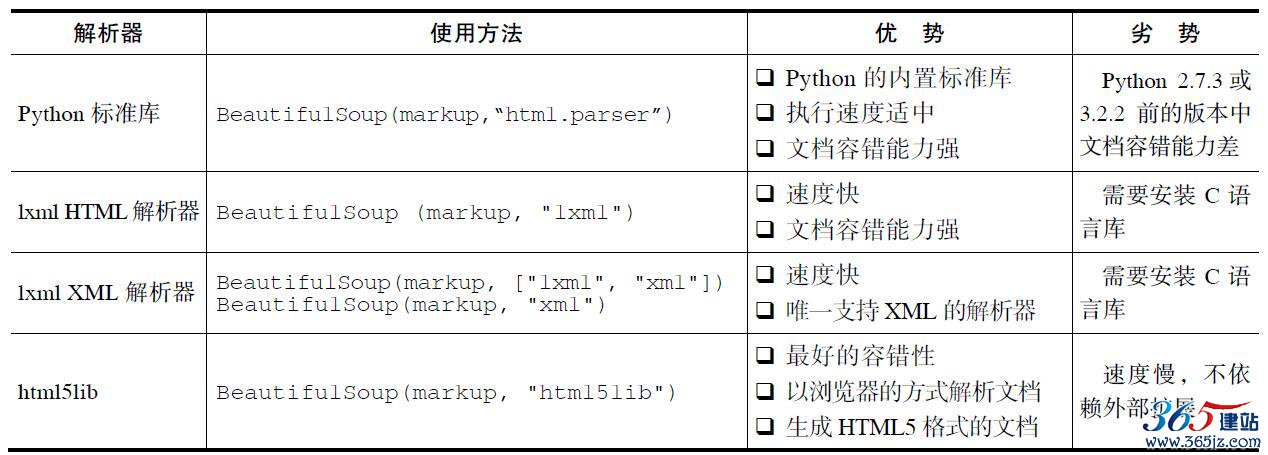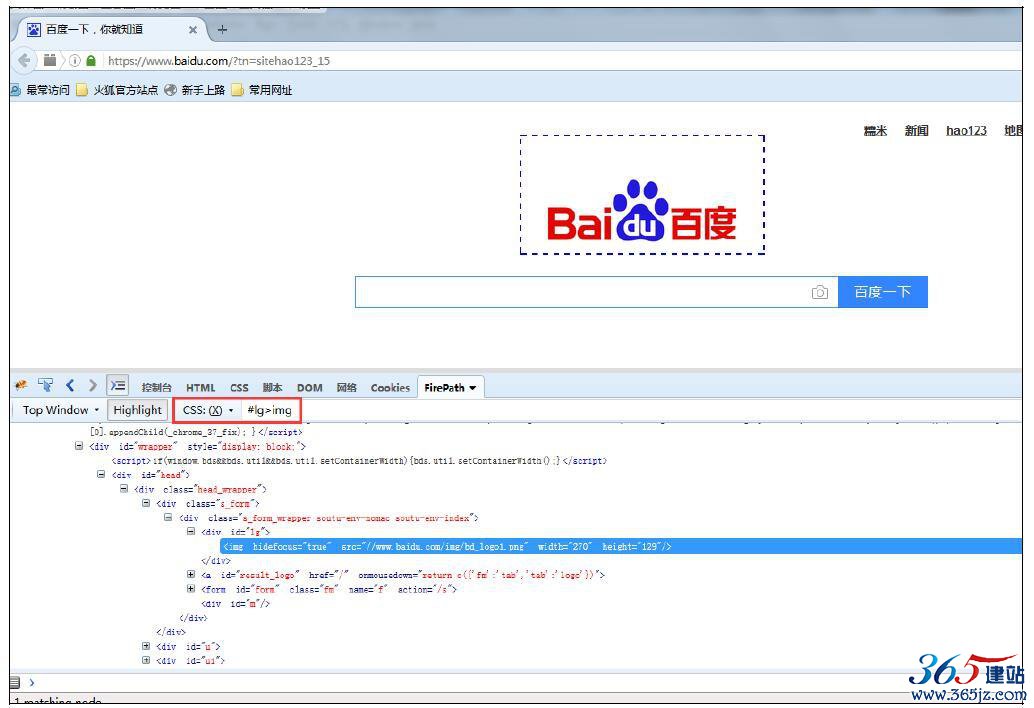Python爬虫制作之Beautiful Soup的用法
强大的BeautifulSoup
Beautiful Soup是一个可以从HTML或XML文件中提取数据的Python库。它能够通过你喜欢的转换器实现惯用的文档导航、查找、修改文档的方式。在Python爬虫开发中,我们主要用到的是Beautiful Soup的查找提取功能,修改文档的方式很少用到。接下来由浅及深介绍Beautiful Soup在Python爬虫开发中的使用。
4.3.1 安装BeautifulSoup
对于Beautiful Soup,我们推荐使用的是Beautiful Soup 4,已经移植到BS4中,Beautiful Soup 3已经停止开发。安装Beautiful Soup 4有三种方式:
·如果你用的是新版的Debain或ubuntu,那么可以通过系统的软件包管理来安装:apt-get install Python-bs4。
·Beautiful Soup 4通过PyPi发布,可以通过easy_install或pip来安装。包的名字是beautifulsoup4,这个包兼容Python2和Python3。安装命令:easy_installbeautifulsoup4或者pipinstallbeautifulsoup4。
·也可以通过下载源码的方式进行安装,当前最新的版本是4.5.1,源码下载地址为https://pypi.python.org/pypi/beautifulsoup4/。运行下面的命令即可完成安装:python setup.py install。
Beautiful Soup支持Python标准库中的HTML解析器,还支持一些第三方的解析器,其中一个是lxml。由于lxml解析速度比标准库中的HTML解析器的速度快得多,我们选择安装lxml作为新的解析器。根据操作系统不同,可以选择下列方法来安装lxml:
·apt-get install Python-lxml·easy_install lxml·pip install lxml
另一个可供选择的解析器是纯Python实现的html5lib,html5lib的解析方式与浏览器相同,可以选择下列方法来安装html5lib:
·apt-get install Python-html5lib·easy_install html5lib·pip install html5lib
表4-9列出了主要的解析器,以及它们的优缺点。

表4-9 解析器比较
从表4-9中可以看出推荐使用lxml作为解析器的原因,因为它效率更高。
4.3.2 BeautifulSoup的使用
安装完BeautifulSoup,接下来开始讲解BeautifulSoup的使用。
1.快速开始
首先导入bs4库:from bs4import BeautifulSoup。接着创建包含
HTML代码的字符串,用来进行解析。字符串如下:
html_str = """
<html><head><title>The Dormouse's story</title></head> <body> <p class="title"><b>The Dormouse's story</b></p><p class="story">Once upon a time there were three little sisters; and their names
were
<a href="http://example.com/elsie" class="sister" id="link1"><!-- Elsie --></a>, <a href="http://example.com/lacie" class="sister" id="link2"><!-- Lacie --></a>
and
<a href="http://example.com/tillie" class="sister" id="link3">Tillie</a>;
and they lived at the bottom of a well.</p> <p class="story">...</p> """
接下来的数据解析和提取都是以这个字符串为例子。
然后创建BeautifulSoup对象,创建BeautifulSoup对象有两种方式。
一种直接通过字符串创建:
soup = BeautifulSoup(html_str,'lxml', from_encoding='utf-8')
另一种通过文件来创建,假如将html_str字符串保存为index.html
文件,创建方式如下:
soup = BeautifulSoup(open('index.html'))
文档被转换成Unicode,并且HTML的实例都被转换成Unicode编码。打印soup对象的内容,格式化输出:
print soup.prettify()
输入结果如下:
<html> <head> <title> The Dormouse's story
</title> </head> <body> <p class="title"> <b> The Dormouse's story
</b> </p> <p class="story"> Once upon a time there were three little sisters; and their names
were
<a class="sister" href="http://example.com/elsie" id="link1"> <!--Elsie --> </a> , <a class="sister" href="http://example.com/lacie" id="link2"> <!--Lacie--> </a> and
<a class="sister" href="http://example.com/tillie" id="link3"> Tillie
</a> ;
and they lived at the bottom of a well.
</p> <p class="story"> ...
</p> </body> </html>
Beautiful Soup选择最合适的解析器来解析这段文档,如果手动指定解析器那么Beautiful Soup会选择指定的解析器来解析文档,使用方法如表4-9所示。
2.对象种类
Beautiful Soup将复杂HTML文档转换成一个复杂的树形结构,每个节点都是Python对象,所有对象可以归纳为4种:
·Tag·NavigableString·BeautifulSoup·Comment1)Tag
首先说一下Tag对象,Tag对象与XML或HTML原生文档中的Tag相同,通俗点说就是标记。比如<title>The Dormouse‘s story</title>或者<a href=“http://example.com/elsie”class=“sister” id=“link1”>Elsie</a>,title和a标记及其里面的内容称为Tag对象。
怎样从html_str中抽取Tag呢?示例如下:
·抽取title:print soup.title·抽取a:print soup.a·抽取p:print soup.a
从例子中可以看到利用soup加标记名就可以获取这些标记的内容,比之前讲的正则表达式简单多了。不过利用这种方式,查找的是在所有内容中第一个符合要求的标记,如果要查询所有的标记,后面的内容进行讲解。
Tag中有两个最重要的属性:name和attributes。每个Tag都有自己的名字,通过.name来获取。示例如下:
print soup.name
print soup.title.name
输出结果:
[document] title
soup对象本身比较特殊,它的name为[document],对于其他内部标记,输出的值便为标记本身的名称。
Tag不仅可以获取name,还可以修改name,改变之后将影响所有通过当前Beautiful Soup对象生成的HTML文档。示例如下:
soup.title.name = 'mytitle'
print soup.title
print soup.mytitle
输出结果:
None
<mytitle>The Dormouse's story</mytitle>
这里已经将title标记成功修改为mytitle。
再说一下Tag中的属性,<p class=“title”><b>The Dormouse’
s story</b></p>有一个“class”属性,值为“title”。Tag的属性的操作方法与字典相同:
print soup.p['class'] print soup.p.get('class')
输出结果:
['title'] ['title']
也可以直接“点”取属性,比如:.attrs,用于获取Tag中所有属性:
print soup.p.attrs
输出结果:
{'class': ['title']}
和name一样,我们可以对标记中的这些属性和内容等进行修改,示例如下:
soup.p['class']="myClass"
print soup.p
输出结果:
<p class="myClass"><b>The Dormouse's story</b></p>
2)NavigableString
我们已经得到了标记的内容,要想获取标记内部的文字怎么办呢?需要用到.string。
示例如下:
print soup.p.string
print type(soup.p.string)
输出结果:
The Dormouse's story
<class 'bs4.element.NavigableString'>
Beautiful Soup用NavigableString类来包装Tag中的字符串,一个
NavigableString字符串与Python中的Unicode字符串相同,通过
unicode()方法可以直接将NavigableString对象转换成Unicode字符串:
unicode_string = unicode(soup.p.string)
3)BeautifulSoup
BeautifulSoup对象表示的是一个文档的全部内容。大部分时候,可以把它当作Tag对象,是一个特殊的Tag,因为BeautifulSoup对象并不是真正的HTML或XML的标记,所以它没有name和attribute属性。但为了将BeautifulSoup对象标准化为Tag对象,实现接口的统一,我们依然可以分别获取它的name和attribute属性。示例如下:
print type(soup.name)
print soup.name
print soup.attrs
输出结果:
<type 'unicode'> [document] {}
4)Comment
Tag、NavigableString、BeautifulSoup几乎覆盖了HTML和XML中的所有内容,但是还有一些特殊对象。容易让人担心的内容是文档的注释部分:
print soup.a.string
print type(soup.a.string)
输出结果:
Elsie
<class 'bs4.element.Comment'>
a标记里的内容实际上是注释,但是如果我们利用.string来输出它的内容,会发现它已经把注释符号去掉了。另外如果打印输出它的类型,会发现它是一个Comment类型。如果在我们不清楚这个标记.string的情况下,可能造成数据提取混乱。因此在提取字符串时,可以判断一下类型:
if type(soup.a.string)==bs4.element.Comment:
print soup.a.string
3.遍历文档树
BeautifulSoup会将HTML转化为文档树进行搜索,既然是树形结构,节点的概念必不可少。
1)子节点首先说一下直接子节点,Tag中的.contents和.children是非常重要的。Tag的.content属性可以将Tag子节点以列表的方式输出:
print soup.head.contents
输出结果:
[<title>The Dormouse's story</title>]
既然输出方式是列表,我们就可以获取列表的大小,并通过列表索引获取里面的值:
print len(soup.head.contents)
print soup.head.contents[0].string
输出结果:
1 The Dormouse's story
有一点需要注意:字符串没有.contents属性,因为字符串没有子节点。
.children属性返回的是一个生成器,可以对Tag的子节点进行循环:
for child in soup.head.children:
print(child)
输出结果:
<title>The Dormouse's story</title>
.contents和.children属性仅包含Tag的直接子节点。例如,
<head>标记只有一个直接子节点<title>。但是<title>标记也包含一个子节点:字符串“The Dormouse’s story”,这种情况下字符串“The Dormouse’s story”也属于<head>标记的子孙节点。.descendants属性可以对所有tag的子孙节点进行递归循环:
for child in soup.head.descendants:
print(child)
输出结果:
<title>The Dormouse's story</title> The Dormouse's story
以上都是关于如何获取子节点,接下来说一下如何获取节点的内容,这就涉及.string、.strings、stripped_strings三个属性。
.string这个属性很有特点:如果一个标记里面没有标记了,那么.string就会返回标记里面的内容。如果标记里面只有唯一的一个标记了,那么.string也会返回最里面的内容。如果tag包含了多个子节点,
tag就无法确定,string方法应该调用哪个子节点的内容,.string的输出结果是None。示例如下:
print soup.head.string
print soup.title.string
print soup.html.string
输出结果:
The Dormouse's story
The Dormouse's story
None
.strings属性主要应用于tag中包含多个字符串的情况,可以进行循环遍历,示例如下:
for string in soup.strings:
print(repr(string))
输出结果:
u"The Dormouse's story"
u'\n'
u'\n'
u"The Dormouse's story"
u'\n'
u'Once upon a time there were three little sisters; and their names were\n'
u',\n'
u' and\n'
u'Tillie'
u';\nand they lived at the bottom of a well.'
u'\n'
u'...'
u'\n'
.stripped_strings属性可以去掉输出字符串中包含的空格或空行,示例如下:
for string in soup.stripped_strings:
print(repr(string))
输出结果:
u"The Dormouse's story"
u"The Dormouse's story"
u'Once upon a time there were three little sisters; and their names were'
u','
u'and'
u'Tillie'
u';\nand they lived at the bottom of a well.'
u'...'
2)父节点继续分析文档树,每个Tag或字符串都有父节点:被包含在某个
Tag中。
通过.parent属性来获取某个元素的父节点。在html_str中,
<head>标记是<title>标记的父节点:
print soup.title
print soup.title.parent
输出结果:
<title>The Dormouse's story</title> <head><title>The Dormouse's story</title></head>
通过元素的.parents属性可以递归得到元素的所有父辈节点,下面的例子使用了.parents方法遍历了<a>标记到根节点的所有节点:
print soup.a
for parent in soup.a.parents:
if parent is None:
print(parent)
else:
print(parent.name)
输出结果:
<a class="sister" href="http://example.com/elsie" id="link1"><!-- Elsie --></a> p
body
html
[document]
3)兄弟节点从soup.prettify()的输出结果中,我们可以看到<a>有很多兄弟节点。兄弟节点可以理解为和本节点处在同一级的节点,.next_sibling属性可以获取该节点的下一个兄弟节点,.previous_sibling则与之相反,如果节点不存在,则返回None。
示例如下:
print soup.p.next_sibling
print soup.p.prev_sibling
print soup.p.next_sibling.next_sibling
输出结果:
None
<p class="story">Once upon a time there were three little sisters; and their
names were
<a class="sister" href="http://example.com/elsie" id="link1"><!-- Elsie --></a>, <a class="sister" href="http://example.com/lacie" id="link2"><!-- Lacie --></a>
and
<a class="sister" href="http://example.com/tillie" id="link3">Tillie</a>;
and they lived at the bottom of a well.</p>
第一个输出结果为空白,因为空白或者换行也可以被视作一个节点,所以得到的结果可能是空白或者换行。
通过.next_siblings和.previous_siblings属性可以对当前节点的兄弟节点迭代输出:
for sibling in soup.a.next_siblings:
print(repr(sibling))
输出结果:
u',\n'
<a class="sister" href="http://example.com/lacie" id="link2"><!-- Lacie --></a> u' and\n'
<a class="sister" href="http://example.com/tillie" id="link3">Tillie</a> u';\nand they lived at the bottom of a well.'
4)前后节点前后节点需要使用.next_element、.previous_element这两个属性,与.next_sibling.previous_sibling不同,它并不是针对于兄弟节点,而是针对所有节点,不分层次,例如<head><title>The Dormouse‘s
story</title></head>中的下一个节点就是title:
print soup.head
print soup.head.next_element
输出结果:
<head><title>The Dormouse's story</title></head> <title>The Dormouse's story</title>
如果想遍历所有的前节点或者后节点,通过.next_elements
和.previous_elements的迭代器就可以向前或向后访问文档的解析内容,就好像文档正在被解析一样:
for element in soup.a.next_elements:
print(repr(element))
输出结果:
u' Elsie '
u',\n'
<a class="sister" href="http://example.com/lacie" id="link2"><!-- Lacie --></a> u' Lacie '
u' and\n'
<a class="sister" href="http://example.com/tillie" id="link3">Tillie</a> u'Tillie'
u';\nand they lived at the bottom of a well.'
u'\n'
<p class="story">...</p> u'...'
u'\n'
以上就是遍历文档树的用法,接下来开始讲解比较核心的内容:
搜索文档树。
4.搜索文档树
Beautiful Soup定义了很多搜索方法,这里着重介绍find_all()方法,其他方法的参数和用法类似,请大家举一反三。
首先看一下find_all方法,用于搜索当前Tag的所有Tag子节点,并判断是否符合过滤器的条件,函数原型如下:
find_all( name , attrs , recursive , text , **kwargs )
接下来分析函数中各个参数,不过需要打乱函数参数顺序,这样方便例子的讲解。
1)name参数
name参数可以查找所有名字为name的标记,字符串对象会被自动忽略掉。name参数取值可以是字符串、正则表达式、列表、True
和方法。
最简单的过滤器是字符串。在搜索方法中传入一个字符串参数,
Beautiful Soup会查找与字符串完整匹配的内容,下面的例子用于查找文档中所有的<b>标记,返回值为列表:
print soup.find_all('b')
输出结果:
[<b>The Dormouse's story</b>]
如果传入正则表达式作为参数,Beautiful Soup会通过正则表达式的match()来匹配内容。下面的例子中找出所有以b开头的标记,这表示<body>和<b>标记都应该被找到:
import re
for tag in soup.find_all(re.compile("^b")):
print(tag.name)
输出结果:
body
b
如果传入列表参数,Beautiful Soup会将与列表中任一元素匹配的内容返回。下面的代码找到文档中所有<a>标记和<b>标记:
print soup.find_all(["a", "b"])
输出结果:
[<b>The Dormouse's story</b>, <a class="sister" href="http://example.com/elsie"
id="link1"><!-- Elsie --></a>, <a class="sister" href="http://example.com/lacie" id="
link2"><!-- Lacie --></a>, <a class="sister" href="http://example.com/tillie" id="link3"
>Tillie</a>]
如果传入的参数是True,True可以匹配任何值,下面代码查找到所有的tag,但是不会返回字符串节点:
for tag in soup.find_all(True):
print(tag.name)
输出结果:
html
head
title
body
p
b
p
a
a
a
p
如果没有合适过滤器,那么还可以定义一个方法,方法只接受一个元素参数Tag节点,如果这个方法返回True表示当前元素匹配并且被找到,如果不是则返回False。比如过滤包含class属性,也包含id
属性的元素,程序如下:
def hasClass_Id(tag):
return tag.has_attr('class') and tag.has_attr('id')
print soup.find_all(hasClass_Id)
输出结果:
[<a class="sister" href="http://example.com/elsie" id="link1"><!-- Elsie --></a>, <a
class="sister" href="http://example.com/lacie" id="link2"><!-- Lacie --></a>, <a
class="sister" href="http://example.com/tillie" id="link3">Tillie</a>]
2)kwargs参数
kwargs参数在Python中表示为keyword参数。如果一个指定名字的参数不是搜索内置的参数名,搜索时会把该参数当作指定名字Tag
的属性来搜索。搜索指定名字的属性时可以使用的参数值包括字符串、正则表达式、列表、True。
如果包含id参数,Beautiful Soup会搜索每个tag的“id”属性。示例如下:
print soup.find_all(id='link2')
输出结果:
[<a class="sister" href="http://example.com/lacie" id="link2"><!-- Lacie --></a>]
如果传入href参数,Beautiful Soup会搜索每个Tag的“href”属性。比如查找href属性中含有“elsie”的tag:
import re
print soup.find_all(href=re.compile("elsie"))
输出结果:
[<a class="sister" href="http://example.com/elsie" id="link1"><!-- Elsie --></a>]
下面的代码在文档树中查找所有包含id属性的Tag,无论id的值是什么:
print soup.find_all(id=True)
输出结果:
[<a class="sister" href="http://example.com/elsie" id="link1"><!-- Elsie --></a>, <a
class="sister" href="http://example.com/lacie" id="link2"><!-- Lacie --></a>, <a
class="sister" href="http://example.com/tillie" id="link3">Tillie</a>]
如果我们想用class过滤,但是class是python的关键字,需要在
class后面加个下划线:
print soup.find_all("a", class_="sister")
输出结果:
[<a class="sister" href="http://example.com/elsie" id="link1"><!-- Elsie --></a>, <a
class="sister" href="http://example.com/lacie" id="link2"><!-- Lacie --></a>, <a
class="sister" href="http://example.com/tillie" id="link3">Tillie</a>]
使用多个指定名字的参数可以同时过滤tag的多个属性:
3)text参数通过text参数可以搜索文档中的字符串内容。与name参数的可选值一样,text参数接受字符串、正则表达式、列表、True。示例如下:
print soup.find_all(text="Elsie")
print soup.find_all(text=["Tillie", "Elsie", "Lacie"])
print soup.find_all(text=re.compile("Dormouse"))
输出结果:
[u'Elsie'] [u'Elsie', u'Lacie', u'Tillie'] [u"The Dormouse's story", u"The Dormouse's story"]
虽然text参数用于搜索字符串,还可以与其他参数混合使用来过滤tag。Beautiful Soup会找到.string方法与text参数值相符的tag。下面的代码用来搜索内容里面包含“Elsie”的<a>标记:
print soup.find_all("a", text="Elsie")
输出结果:
[<a class="sister" href="http://example.com/elsie" id="link1"><!--Elsie--></a>]
4)limit参数
find_all()方法返回全部的搜索结构,如果文档树很大那么搜索会很慢。如果我们不需要全部结果,可以使用limit参数限制返回结果的数量。效果与SQL中的limit关键字类似,当搜索到的结果数量达到
limit的限制时,就停止搜索返回结果。下面的例子中,文档树中有3
个tag符合搜索条件,但结果只返回了2个,因为我们限制了返回数量。
print soup.find_all("a", limit=2)
输出结果:
[<a class="sister" href="http://example.com/elsie" id="link1"><!--Elsie--></a>, <a
class="sister" href="http://example.com/lacie" id="link2"><!--Lacie--></a>]
5)recursive参数调用tag的find_all()方法时,Beautiful Soup会检索当前tag的所有子孙节点,如果只想搜索tag的直接子节点,可以使用参数
recursive=False。示例如下:
print soup.find_all("title")
print soup.find_all("title", recursive=False)
5.CSS选择器
在之前Web前端的章节中,我们讲到了CSS的语法,通过CSS也可以定位元素的位置。在写CSS时,标记名不加任何修饰,类名前加点“.”,id名前加“#”,在这里我们也可以利用类似的方法来筛选元素,用到的方法是soup.select(),返回类型是list。
1)通过标记名称进行查找通过标记名称可以直接查找、逐层查找,也可以找到某个标记下的直接子标记和兄弟节点标记。示例如下:
# 直接查找title标记
print soup.select("title")
# 逐层查找title标记
print soup.select("html head title")
# 查找直接子节点
# 查找head下的title标记
print soup.select("head > title")
# 查找p下的id="link1"的标记
print soup.select("p > # link1")
# 查找兄弟节点
# 查找id="link1"之后class=sisiter的所有兄弟标记
print soup.select("# link1 ~ .sister")
# 查找紧跟着id="link1"之后class=sisiter的子标记
print soup.select("# link1 + .sister")
输出结果:
[<title>The Dormouse's story</title>] [<title>The Dormouse's story</title>] [<title>The Dormouse's story</title>] [<a class="sister" href="http://example.com/elsie" id="link1"><!--Elsie--></a>][<a class="sister" href="http://example.com/lacie" id="link2"><!--Lacie--></a>, <a
class="sister" href="http://example.com/tillie" id="link3">Tillie</a>] [<a class="sister" href="http://example.com/lacie" id="link2"><!--Lacie--></a>]
2)通过CSS的类名查找示例如下:
print soup.select(".sister")
print soup.select("[class~=sister]")
输出结果:
[<a class="sister" href="http://example.com/elsie" id="link1"><!--Elsie--></a>, <a
class="sister" href="http://example.com/lacie" id="link2"><!--Lacie--></a>, <a
class="sister" href="http://example.com/tillie" id="link3">Tillie</a>][<a class="sister" href="http://example.com/elsie" id="link1"><!--Elsie--></a>, <a
class="sister" href="http://example.com/lacie" id="link2"><!--Lacie--></a>, <a
class="sister" href="http://example.com/tillie" id="link3">Tillie</a>]
3)通过tag的id查找示例如下:
print soup.select("# link1")
print soup.select("a# link2")
输出结果:
[<a class="sister" href="http://example.com/elsie" id="link1"><!--Elsie--></a>] [<a class="sister" href="http://example.com/lacie" id="link2"><!--Lacie--></a>]
4)通过是否存在某个属性来查找示例如下:
print soup.select('a[href]')
输出结果:
[<a class="sister" href="http://example.com/elsie" id="link1"><!--Elsie--></a>, <a
class="sister" href="http://example.com/lacie" id="link2"><!--Lacie--></a>, <a
class="sister" href="http://example.com/tillie" id="link3">Tillie</a>]
5)通过属性值来查找示例如下:
print soup.select('a[href="http://example.com/elsie"]')
print soup.select('a[href^="http://example.com/"]')
print soup.select('a[href$="tillie"]')
print soup.select('a[href*=".com/el"]')
输出结果:
[<a class="sister" href="http://example.com/elsie" id="link1"><!--Elsie--></a>][<a class="sister" href="http://example.com/elsie" id="link1"><!--Elsie--></a>, <a
class="sister" href="http://example.com/lacie" id="link2"><!--Lacie--></a>, <a
class="sister" href="http://example.com/tillie" id="link3">Tillie</a>] [<a class="sister" href="http://example.com/tillie" id="link3">Tillie</a>] [<a class="sister" href="http://example.com/elsie" id="link1"><!--Elsie--></a>]
以上就是CSS选择器的查找方式,如果大家对CSS选择器的写法不是很熟悉,可以搜索一下W3CSchool的CSS选择器参考手册进行学习。除此之外,还可以使用Firebug中的FirePath功能自动获取网页元素的CSS选择器表达式,如图4-25所示。

图4-25 FirePath CSS选择器
4.3.3 lxml的XPath解析
BeautifulSoup可以将lxml作为默认的解析器使用,同样lxml可以单独使用。下面比较一下这两者之间的优缺点:
·BeautifulSoup和lxml的原理不一样,BeautifulSoup是基于DOM的,会载入整个文档,解析整个DOM树,因此时间和内存开销都会大很多。而lxml是使用XPath技术查询和处理HTML/XML文档的库,只会局部遍历,所以速度会快一些。幸好现在BeautifulSoup可以使用
lxml作为默认解析库。
·BeautifulSoup用起来比较简单,API非常人性化,支持CSS选择器,适合新手。lxml的XPath写起来麻烦,开发效率不如BeautifulSoup,当然这也是因人而异,如果你能熟练使用XPath,那么使用lxml是更好的选择,况且现在又有了FirePath这样的自动生成
XPath表达式的利器。
第2章已经讲过了XPath的用法,所以现在直接介绍如何使用lxml
库来解析网页。示例如下:
from lxml import etree
html_str = """
<html><head><title>The Dormouse's story</title></head> <body> <p class="title"><b>The Dormouse's story</b></p><p class="story">Once upon a time there were three little sisters; and their names
were
<a href="http://example.com/elsie" class="sister" id="link1">Elsie</a>, <a href="http://example.com/lacie" class="sister" id="link2">Lacie</a> and
<a href="http://example.com/tillie" class="sister" id="link3">Tillie</a>;
and they lived at the bottom of a well.</p> <p class="story">...</p> """
html = etree.HTML(html_str)
result = etree.tostring(html)
print(result)
输出结果:
<html><head><title>The Dormouse's story</title></head> <body> <p class="title"><b>The Dormouse's story</b></p><p class="story">Once upon a time there were three little sisters; and their names
were
<a href="http://example.com/elsie" class="sister" id="link1"><!--Elsie--></a>, <a href="http://example.com/lacie" class="sister" id="link2"><!--Lacie--></a>
and
<a href="http://example.com/tillie" class="sister" id="link3">Tillie</a>;
and they lived at the bottom of a well.</p> <p class="story">...</p> </body></html>
大家看到html_str最后是没有</html>和</body>标签的,没有进行闭合,但是通过输出结果我们可以看到lxml的一个非常实用的功能就是自动修正html代码。
除了读取字符串之外,lxml还可以直接读取html文件。假如将html_str存储为index.html文件,利用parse方法进行解析,示例如下:
from lxml import etree
html = etree.parse('index.html')
result = etree.tostring(html, pretty_print=True)
print(result)
接下来使用XPath语法抽取出其中所有的URL,示例如下:
html = etree.HTML(html_str)
urls = html.xpath(".// *[@class='sister']/@href")
print urls
输出结果:
['http://example.com/elsie', 'http://example.com/lacie', 'http://example.com/tillie']
使用lxml的关键是构造XPath表达式,如果大家对XPath不熟悉,可以复习一下第2章中XPath内容。
4.4 小结
本章主要讲解了HTML解析的各种方式,这也是提取网页数据非常关键的环节。希望大家把正则表达式、Beautiful Soup和XPath的知识做到灵活运用。同时还要注意Firebug、FirePath和Match Tracer的配合使用,将会使开发达到事半功倍的效果。
如对本文有疑问,请提交到交流论坛,广大热心网友会为你解答!! 点击进入论坛

